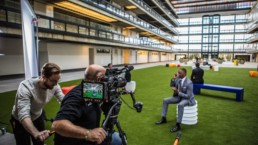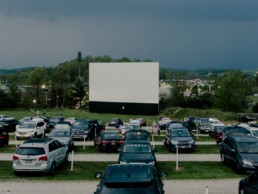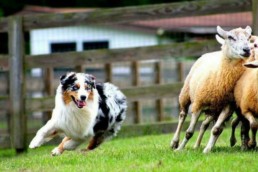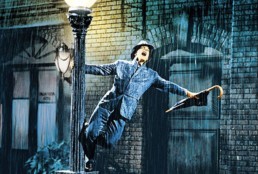The Value of Production Value
What is production value anyway? By definition, production value is:
The lighting, sound, scenery and props used to improve a film or play.
Simply put, it’s the money spent on what the viewer sees on screen. But, that doesn’t mean an expensive production equals a successful production. You can spend the majority of your budget on a costume, location or camera package, but if the creativity and story is low quality, the final product will be too. It also doesn’t mean that every production needs to look like a Christopher Nolan movie to be successful. The right production value is what matters - for your brand, your audience, and your message (and in reality, your budget!).
For us at Spot, the first questions we ask our clients when engaging a new project are:
1) What is your core message(s)?
2) Who is your audience(s)?
The answers to these questions are the most crucial to understand because delivering to those accurately will result in positive reactions to your media and, ultimately, engagement with your brand. These are more important than the amount of money that you spend on production value. You could have a singular message but multiple audiences that need to absorb it OR multiple messages that you need to get across in a single video - either way, you need to make sure you allocate enough of the budget into what matters most to deliver the core message(s) to the core audience(s). High production value without clear and targeted messaging is essentially… useless. As the saying goes, content is king.
Take the current situation, a global pandemic that has completely changed the way we interact. Production was halted across the globe, while messaging became even more critical as brands needed to articulate their reactions and next steps more clearly than ever. Lower “remote” production value has become acceptable by audiences in TV and marketing. Talk shows like The Tonight Show Starring Jimmy Fallon, have continued to broadcast without their expensive stages and fancy cameras, proving that the audiences are coming back for the content - what it’s always been about. If you want a sample of some of this self-recorded content, also check our own video explainer on the topic.
The last thing we ask a client is about their budget - and how to navigate this can be challenging. The exact ROI of video is difficult to calculate in many instances. It’s a long-term investment if you want to keep engaging viewers with video. That means coming out of the gate you might not need something that is visually expensive. You can build up your production value over time as you grow, learn what works, and see a return on that media. And don’t let budget restrictions stop you from promoting with video. If you are working with a good team, you can figure out a way to get it done.
Overall, my advice is to invest in your team first, work with and hire diverse people and organizations that think differently than you do, who are passionate about your brand and mission. Invest in creative second, which you can do in more ways than just your wallet. From here, you’ll be well on your way to defining your brand’s authentic voice and the appropriate production value will follow. Remember, I’ve seen successful campaigns for $5,000, and unsuccessful campaigns for $500,000. That being said, always keep expectations in check. Don’t go into a project expecting a Picasso with the budget for an Ikea print.
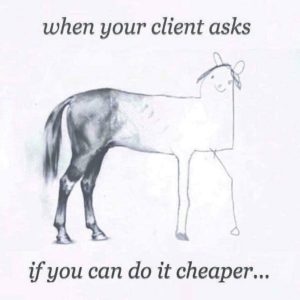
Brittany Santagata, Head of Production
The Return of the Drive-In Theater
Over the past few weeks news of a drive-in theater resurgence has circulated, with dozens of new drive-ins being prepped to open in the coming weeks - at vacant lots, sites of once-drive-ins that closed long ago, even Yankee Stadium.
I tried to remember my first drive-in movie and I began to picture it vividly: The Shining. Jack’s hacking away at the bathroom door and then lightning strikes and a tornado tears apart the massive movie screen. Then, I realized this was a scene from the movie Twister.
My first drive-in movie was actually True Lies (another Paxton classic) in Ontario with my parents in 1994. Where, fortuitously, a tornado really damaged a drive-in theater two years later. A day that Twister set to screen. This story unfurled into an urban legend claiming the theater was demolished while the movie was playing, spawning a Mandela effect-level mythos where (like me) witnesses confabulated their own memories (See: Twisted Short Documentary).
It’s this kind of storied past that I think sticks with the drive-in and transcends from the gimmick of “outdoor movie theater” to more of a “sacred ground” where families and couples can laugh, cry and be “alone” together without ever really being alone.
Dating back as early as 1915, outdoor and “drive-in” film viewings took place in different parts of America. The first patented drive-in, as we know them, took place in Pennsauken, NJ in 1933 with the concept catching fire shortly after until it would become a quintessential component of 1950’s Americana culture along with diners, muscle cars, and things you saw in Grease.
More cars and more kids meant more drive-ins, and the number of theaters nationwide surged from 155 in 1947 to a whopping 4,151 in 1951. The industry would survive for roughly two more decades before it's inevitable decline as a hotspot for recreation, a place to escape on warm summer nights and a passion pit for romantics.
It was a combination of home entertainment, daylight savings, compact cars and real estate that killed the drive-in. With less nighttime to show films in peak season, less space to sprawl out, more space and options at home with cable and VCRs, and more profit to be made from malls and complexes - It was high time for a seasonal business dependent on the weather.
And as theaters died off across the country, their demographic transformed and the drive-in took on a new seedier, grindhouse-like persona as surviving theaters screened slashers, exploitation films, b-movies and x-rated material. They gradually closed and faded away, an echo of an era, but a fondly remembered one.
There are 300 some-odd drive-ins left in America today - and more expected to open soon. Existing, open drive-ins have been packed these past few weeks (NYT - Thrills, Chills, Popcorn and Hand Sanitizer ). So, it’s not hard to imagine a comeback for the pastime, especially within our nostalgia-consuming culture. If the new temporary and makeshift drive-ins can continue to succeed in-season after quarantine, then they could once again become enduring fixtures of entertainment.
We’re living in a hybrid age of Multipurpose Retail with coffee shops that double as bars and bookstores. Why not marketplaces and parking lots that become drive-in theaters at dark? Movie theater chains could similarly transform their own lots into drive-ins during summer months.
And if not, and the drive-in dies off again with the quarantine, then these pop-up theaters will have served as a glint of hope during a period of uncertainty and longing. A suitable epilogue chapter for an experience we almost forgot.
Whether torn down by a twister or revitalized by a pandemic, the drive-in is an experience as wistful as it is thrilling and I’ll be going soon.
Jeff Mack, Copywriter
Sheep Dog Circles: How to Production Manage In a World Without Production
On a day around this time of year many years ago, I was at an event for my high school. Picture lots of green grass, 300 teenagers and sunshine. I was chatting with friends, when I saw that my teacher’s Australian Shepherd, Kylie, escaped and got off her leash. I knew this dog’s manic energy, so I made no attempt to help catch her, instead I watched. She whipped through the clusters of teens. What appeared to be pent up energy and aimless sprinting began to reveal a pattern of concentric circles. It’d been a minute since I’d seen Chris Noonan’s classic “Babe,” but “Could Kylie be trying to herd us?” I thought to myself. “Could this suburban dog be attempting to work? To try the career encoded into the DNA of her breed? Is this a thing?” Well, I’ve been thinking about Kylie and her circles a lot recently. Amidst all of this change and uncertainty, I’ve had time to think about her working instincts and examine mine as well.
At Spot Creative, I’m a Production Manager on set. I make sure filming goes smoothly, manage logistics, and boost morale. A detailed shoot schedule starting at 7:00 AM with just the right amount of wiggle room? Part of my balanced breakfast. A piece of equipment malfunctioned? My snack of choice. Our location contact is late? Bon Appetit! My Contingency planning has become a bit of a hobby for me and organizing information for others to consume is a great joy of my life. I communicate with a lot of people in a lot of different departments. I get to touch every moving part of the day. Production Management and my fastidiousness go together like dill and pickles, mango and salsa, garlic and mayonnaise. Without a production to manage, you could say that I’m a bit of a Sheepdog without sheep, running in circles.
So where is the sheepdog spending her quarantine? I am by the sea in Gloucester, Massachusetts with my family of four. I have a father, a mother, a brother, and a dog. How have they embraced my scrupulous nature? It’s been a story of accommodation on all sides. Can I treat my household like a set? No. Do I find myself doing that anyways? Yes. Do I get stuck in the precise nature that makes me a good production manager? Yes.
But, as I’ve learned, my father does not need to stick to a schedule. He’s retired. He can wait to use the one yoga mat in the house. My mother’s cooking does not need to be overseen, because it’s food and no one has allergies. It’ll be fine. My brother does not clean the cast iron skillet ever, but he’s the only one that uses it. My family can sense my tension when I feel something small may be going awry, and they just laugh. “Oh Isabel” is my mother’s new go-to consolatory phrase.
My attempts to schedule my day and those of my family members are met with changing whims and activities. Initially, I struggled. I need to eat by 8:00 PM! And who‘s going to walk the dog? But with laughter, I ask “why the discomfort Izzy?” Why? It’s not my family causing this agita, it’s my psyche indulging in it! I’m learning I need to manage my own expectations, my own outlook. I’m beginning to understand how I exist in relation to others. The fog lifts as I let go, more and more over time. The agita evaporates; the tension slackens.
Have I ever thought about my role as Production Manager in relation to others? Yes, in the sense that if I was good at my job people would want to work with me again, but I never thought beyond that. As I mentioned earlier, I work with every department, but I am ashamed to say that I often viewed them as working for me. Yes, I’m a team player and I have a positive attitude, but working with someone is very different than working for them.
I can do better to acknowledge my limits as a Production Manager. The line between helpful guidance and micromanaging is not nearly as fine as I thought. I can trust more. I can let more non-important things go. My helpful chimes do not count as teamwork. Overseeing the packing of the equipment van does not count as collaborative work. Triple checking the work of different departments can be reduced to double. I am not responsible for the bad mood of the director of photography, though I can attempt to brighten it.
My revelations may only relate to Kylie, the Australian Sheepdog, tangentially, but her instincts allow her to see work where there isn’t any. To Kylie, we’re all just a herd in need of help. However my crew members are not a bunch of lost sheep; I do not need to run circles around them. Seeing Kylie’s relentlessness has allowed me to examine my own. Managing myself has become paramount to managing others. It may not be an easy path ahead, but I’m confident it will be a fruitful one.
Izzy Connolly, Production Manager
#MusicMovieMondays
I am continually surprised by the impact music has in film and, in turn, on me. When used well, it can be so poignant and so present (even when it’s not present at all). And there are infinite inventive ways that filmmakers have incorporated music to convey disparate responses within moments, scenes, even lapses - to move us, to drive the story, to set it back, to connect the dots or reveal something - virtually limitless variety. Listen along while you read with our Spotify Playlist.
Here are a few of the countless ways music can have impact on screen:
In Back to the Future, Chuck Berry’s Johnny B. Goode serves a variety of purposes in a pivotal scene - it drives the plot, it’s a fun gag, and it delivers on the premise of the movie.
Music can be used to tell a character something like Peter Gabriel’s In Your Eyes in Say Anything (I love you) or Patrick’s monologue about Whitney Houston’s Greatest Love of All in American Psycho (I’m crazy).
To tell the audience something - John Williams’ looming cues in Jaws or when the Smith’s Panic [on the streets of London] finishes a newscaster’s statement in Shaun of the Dead.
To define or reveal something about a character - Dixon listening to ABBA’s Chiquitita in Three Billboards Outside Ebbing, Missouri, Alex’s Singing In the Rain rendition in A Clockwork Orange, or Teddy blasting Bob Seger’s Feel Like a Number in Body Heat.
To set a mood - Morricone’s score for Once Upon a Time in America integrates McCartney’s Yesterday while Noodles reflects on his past.
Place - 007 soundtracks incorporate regional instruments and styles to better establish new locations.
Period - Suddenly we know we’ve travelled to the 1920’s when “Cole Porter” plays Let’s Do It at the party in Midnight In Paris.
Or a specific time - Sonny & Cher’s I Got You Babe transports us back to 6:00 AM on February 2nd in Groundhog’s Day again and again and again.
There are callbacks to themes used earlier in a movie, reconfigured to evoke opposing emotions. A technique from musical theater that Pixar borrows to pull at our heartstrings in final acts. Giacchino does this in Up and in Coco with Benjamin Bratt’s Remember Me. Randy Newman calls back his own You’ve Got a Friend in Me theme 15 years later with Toy Story 3.
And callbacks to themes from other movies. Wagner’s Ride of the Valkyries (Apocalypse Now), and Vangelis’s theme from Chariots of Fire have been used to death as a shortcut for similar or parody sequences throughout media.
More specifically, BJ Thomas’s Raindrops Keep Fallin’ On My Head and The Rolling Stones’ Can’t You Hear Me Knocking, appearing in Butch Cassidy and the Sundance Kid and Blow, reappear referentually in Spider-Man 2 and Spider-Man: Homecoming, respectively.
There are countless successful relationships between directors and composers that allow for unconventionality and breakthrough thanks to a sense of trust (Paul Thomas Anderson/Lynne Ramsay and Jonny Greenwood).
Sometimes filmmakers feature the work of a singular recording artist in addition to or in place of a traditional score, like Cat Stevens for Harold and Maude, Air with The Virgin Suicides or Elliott Smith in Good Will Hunting.
And although it’s not even close to being on the same scale or magnitude of any of these examples, it can still be fun, pensive and rewarding to drive musical direction for smaller projects. Selecting licensed or stock tracks or collaborating with my great friend, composer Griffin Urbano who finishes my sentences and never ceases to surprise me - whether it is a sting for a sitcom parody or a moving anthem to celebrate countries all over the world.
Over the coming weeks, we’ll explore this magical collision of mediums in an attempt to go beyond the tip of the iceberg (cue Celine Dione), and highlight a bunch of moments and sequences, some clever, some strange, most melodic.
Jeff Mack, Copywriter
Finding Light (at the End of the Tunnel)
When Spot opened its doors in 1998, Clinton was president, Titanic was the number one movie at the box office and we had just bought our first hard drive for around $5,000. It weighed 25 lbs. Times have changed, and so have we. In light of current circumstances, I find myself reflecting. Spot Creative has weathered its share of storms - 9/11, the 2008 recession - but nothing quite like our current moment. Yet the more I think about now, the more I return to our past and find lessons to glean and stories worth telling. Lessons and stories in which we overcame, learned, grew and inspired.
In 2001, we were still a young company. We built our business knocking out one project after another while being creatively led by our partners with our focus primarily on the execution of production. We offered fewer services and were less efficient than today, but it was working. We were building a client base, a brand and an identity as a company partners could trust. Then 9/11 happened, and as anyone living/working in NYC during that time can attest, everything changed. In the immediate aftermath there was a lot of confusion, it took a long time to figure out what it all meant and what we should do. Some of that confusion came from being split between two worlds. One that was working on local recovery and the other that was business as usual for partners in places not directly affected. It was challenging to do both.
The one thing that was simple was to give back, so we did a lot of things. Donated money directly to some, paid for hotel rooms for others and went down to Canal Street to cook for the First Responders. The one story I always remember was at a restaurant called Nino’s that closed for normal business and just fed the workers from the pile. I remember I was cooking with someone and they just said “OK, I’ve got to go so you should start breakfast.” I asked, “how many should I expect” and he answered “...four hundred.” I took a breath and immediately started opening cases of sausage and dumping them into large trays. I put something like ten full trays into the pizza ovens and then got started on the eggs. Right before he left I asked who’s in charge, he took a quick look around and said “You are!” I still remember watching the first responders enjoy those meals. It was the best part, hands down.
From there, we started working on projects like “In Memoriam’ to remember the people who died in the attack. Some others that honored the First Responders and all they risked. A number of our partners were telling the story of how America had and will continue to come through the hardest times. One piece we produced had America’s top CEOs talking about where America and the World was headed in a post 9/11 world. It was an incredible story of how 9/11 brought us together. These projects were in many ways a forerunner to our current partnership with the 9/11 Memorial & Museum.
Our business decreased by at least 50% and we survived by not paying ourselves and putting our team and partners first. The work during this time helped get Spot back on track, and as a New Yorker, it was therapeutic. In many ways, we felt like the same company but looking back now it’s clear we had evolved. Our projects grew more complicated and ironically our dedication to NYC institutions led to filming more out of state and internationally. We began producing independent films, both short and feature length as well. What at the time had felt like keeping our head above water had, gradually, landed us in a really good place. A place where we were able to balance our corporate and commercial work with personal passion projects. Projects that stretched our creative brains in ways that would, in time, trickle down to work with our trusted partners.
Then came 2008. The Financial Crisis was an odd period and in many ways more challenging than 9/11 to weather. There was no one moment to fixate on, no heroes to rally around, just a lot of people struggling, us among them. We had some very slow months but managed to get through it, thankfully. Over the course of a difficult 12-18 months, we got back to normal, but much like 2001 it was a new normal. To compete in a crowded market place, we began expanding our creative and conceptual offerings. They say constraints breed creativity and the economic downturn was certainly that for Spot. It put us on a trajectory that’s grown over the past decade transforming us from production company to creative content agency.
Over the years, our team has accomplished so much and I'm truly proud of them . They listen to our partners and work hard to build an intimate understanding of their needs. They create beautifully designed and inspiring presentations, and most importantly they present a process that’s refined, aligned, and on target for their brand and budget. They’re modular in production and maximize value. They leverage the media across multiple platforms, and deliver optimal content for each. And most importantly, they know there is a deep trust and collaboration at the core of all great partnerships.
Every company goes through cycles. When you’ve been in business this long, you can easily look back and remember periods that were tougher than others. The more I reflect (which I’ve had a lot of time to during quarantine) the more I realize that the times that are most challenging have led to many of the best decisions we’ve made over our 20 years as a company. This pandemic raises unique challenges, one’s we’re already exploring from both creative and production angles. Challenges we’re collaborating with our partners on solutions for, things like digital events and messaging to name a few.
I think we all had a different idea of what 2020 would be like. We’ve had to make some difficult decisions and work towards a vision to get through this period which is unlike any other in the past. We know this too shall pass in time, but the day to day makes you reflect on where you've been and where you’re going. We’re all on a unique journey and these moments can become a transition to something unexpected and potentially wonderful. If we choose to have hope and to remember even when it feels like the sky is falling somewhere there's light at the end of the tunnel.
- Rick Edrich, Co-founder & Executive Producer
On Virtual Directing
A ton of people have been posting great articles on the most effective ways to “Work from Home.” I especially recommend a post by my friend, Derek (a video editor and long-time WFHer) and an article by our partner Jeremy, of Ray Bloch, on the importance of storytelling and community in these trying times. These are two challenges I’ve been grappling over the past couple weeks, as a director and as part of Spot Creative. How do you truly WFH in our industry without the usual tools at our disposal? Luckily for me, an opportunity fell into my lap just a few days ago. One that proved to be enriching both personally and professionally.
Kris and Ricky are my lifelong friends. Both were in my wedding less than a year ago. Both were also some of the earliest members in my film crew: writers, actors, occasional grips nearly 25 years ago. As this global crisis continued to develop, we, like many of us, felt a pull to connect even more than usual, albeit in an entirely virtual way. We have a leaderboard for most time spent exercising, amount of food photos sent, beard growth and the like. Ricky is a lawyer and truly a great dude living in our home state of New Jersey. Kris is a principal of a Washington, DC school and also an excellent dude. His work is also going all digital/virtual in the days ahead. So when it came time for this transition, Kris asked if we could help him out. Ricky and I jumped at the chance to recreate those film crew memories from high school.
The idea: create a welcome video for Kris’ now digital school. The premise: Principal Kris falls asleep and wakes up as his Apple emoji avatar… so if he’s now digital, maybe the school can be too? (Kris was always the corniest of us.) The approach: Kris acts, Ricky writes, and I direct.
Not surprisingly, pre-production wasn’t all that different. I asked Kris to draft a document outlining what he wanted to achieve and the basic story points. Ricky filled out some of the dialog, I punched it up and added a level of cohesion. Once the script was in place, I drew up some storyboards (I promise, this level of artistic complexity is impressive for me) and shared them with the team.
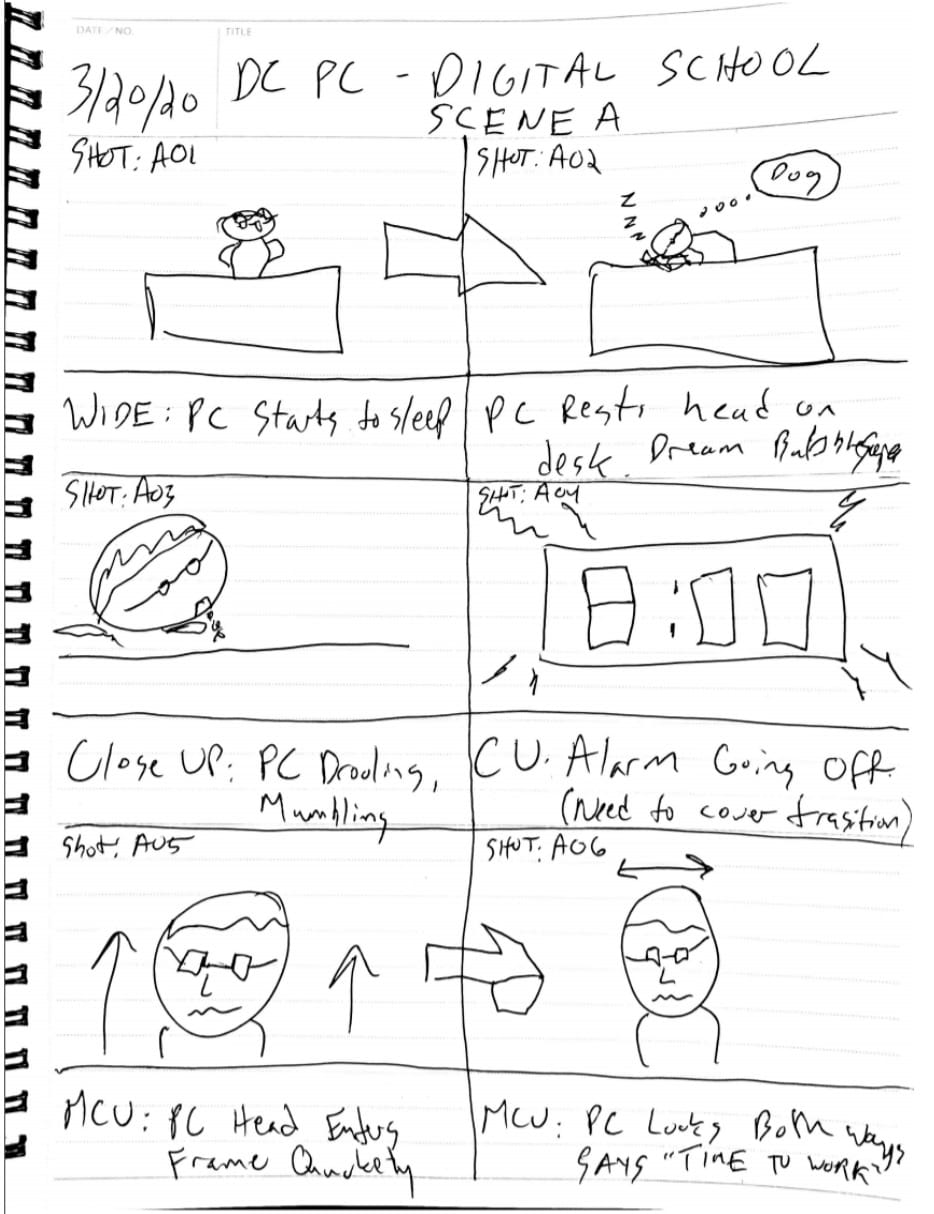
The added challenge of this was the visual effects element of the piece, since we needed to account for the tracking of Kris’s animated head to his real body, both in blocking and in creating cut points. In addition to that, I’d be taking on the VFX work with rudimentary keyframing, so our toolbox was further limited. We had a video chat the night before filming so I could further understand Kris’s needs, convey my approach, discuss challenges and hammer out a schedule. This is a good time to point out that we had no budget and no crew. Kris would be shooting on this iPhone (the newest 11 Pro, which provides solid video resolution considering) and I’d be directing via the same video chat. Luckily, the school was already closed to students so Kris could safely produce this on his last day in the office before everything went digital.
Production, however, was very different. I set up a calendar invite like I would for any video chat, and this would be the proxy for Ricky and I being physically on set. Kris rigged his laptop directly next to the iPhone that he was using to film. The angle wasn’t perfect, but it worked. (I’d find a few eyeline issues later in post.) I set out my boards in front of me in Brooklyn, watching from my couch as Kris adjusted his framing in Washington, DC and Ricky watched on, as a combination of moral support and comic-relief from New Jersey. After I yelled “ACTION!”, we muted our microphones and watched Kris’s first take until I unmuted to yell “CUT!”
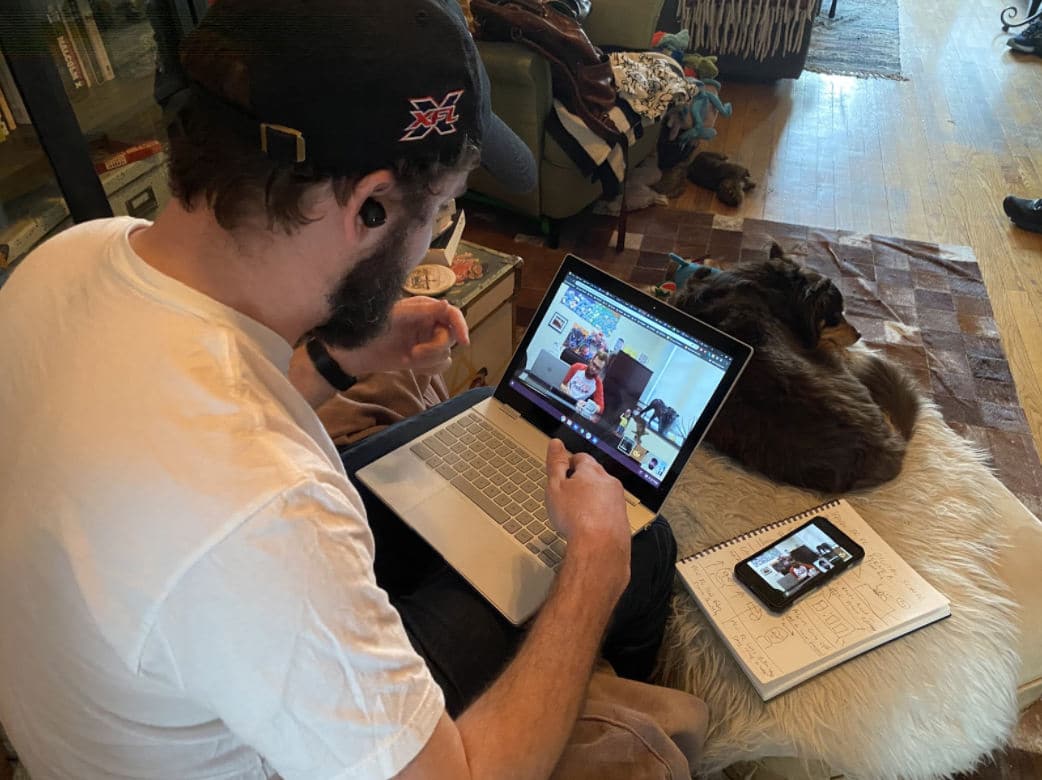
My first thought was “I forgot how limited Kris’s range was…” and my second thought was, “this system kind of works!” I talked Kris through his performance as well as the blocking to account for the digital image of his head that would be added during post production. He couldn’t overlap his hands over his face or have an important prop too close to his head in order to account for the space needed for his digital head overlay. And then Ricky would occasionally chime in with a script note or a sometimes helpful, always funny, suggestion.
Having the familiarity of a decades-long friendship helped with the short-hand style of communication that proves to be integral on-set, but directing via a video screen was not as challenging as I may have thought previously. I was able to convey blocking notes, emotional direction and timing similar to how I would if I were physically present onset, and the dual monitor setup with video chat worked well enough as a director’s monitor. I’m sure this process isn’t completely new to the industry, but I immediately saw potential for application with partners at Spot. Could this be a viable way to use technology to bring together various expertise of filmmaking into space one, albeit virtually? And was Ricky in a way a proxy for a new format of “on-set” partner/client participation as well? PS: The producer in me could also take pride in the fact we finished on time and on budget!
The post-production process was largely the same as we’d approach any project, excluding the fact that I did each step myself and the resources were extremely limited. Apologies in advance for the quality of the motion tracking! I cut my selects the same day once Kris had uploaded the footage. If I had access to the equipment available at Spot, the results would’ve been more refined, but as is the adage with our current times, we adapted, we improvised, and we overcame. He recorded the emoji head videos directly on his phone while listening to playback to get the timing right. Sync wasn’t 100% perfect but it moved the spirit and voice of the piece along. Once I had those recorded, I keyed, re-sized and keyframed that over the “IRL” (in-real-life) video.
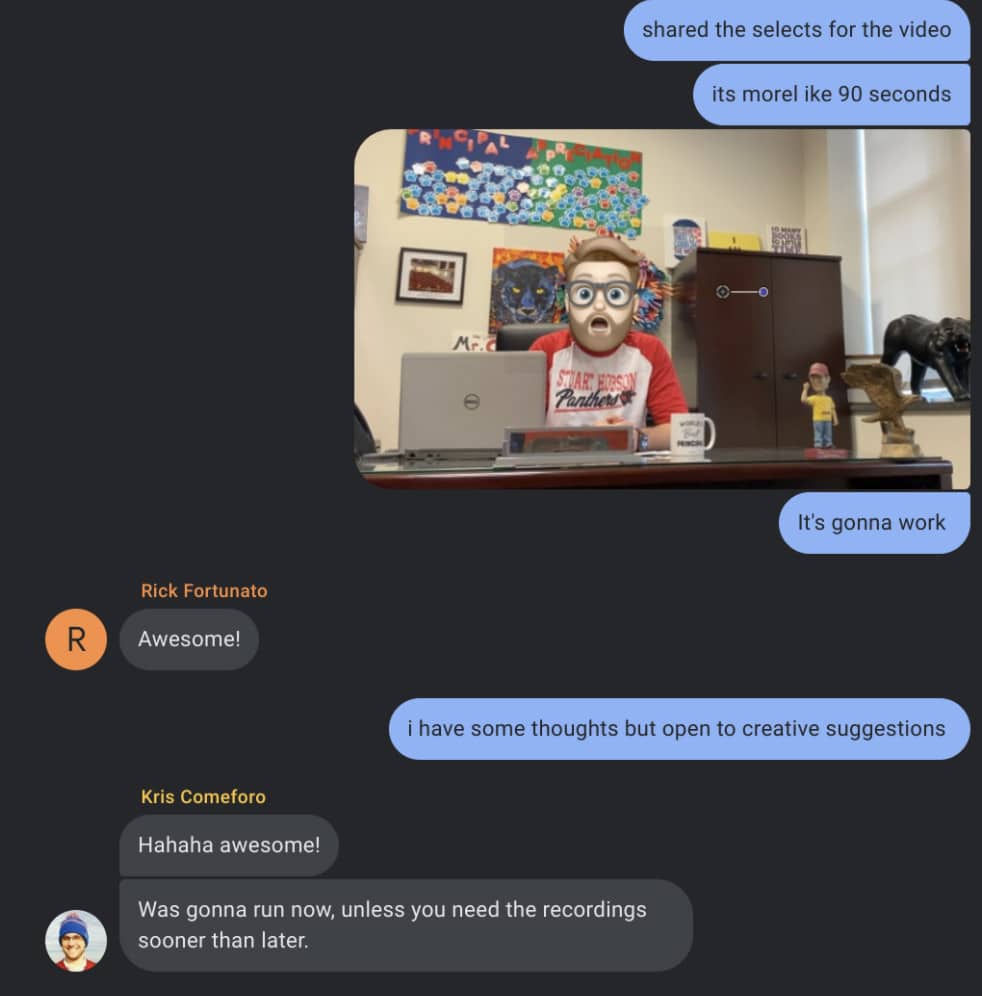
Kris had to re-take one or two for timing, but a few hours later we had a full rough cut. Luckily, Kris and Ricky were easy partners with minor notes. I added music, SFX, and a few small digital effects, and we were done. From conception to final delivery in under 3 days, Kris would post it to Youtube and Twitter the following morning, the first day of digital classes for his students and parents.
The final product clearly has a kid-friendly and DIY feel. The camera is static, the audio is recorded from airpods and the visual effects are far from professional, but what I don’t think can be understated is the impact the piece has had on the students and parents. From nearly the minute Kris posted the video, people were commenting. The Youtube comments were eventually disabled because middle-schoolers can be a tough audience, especially in an internet comments section. But for the parents especially, this silly little video meant a lot during a difficult time. They appreciated the care and frankly just being spoken to directly, being remembered in the uncertain times. The smallest thing clearly meant a lot.
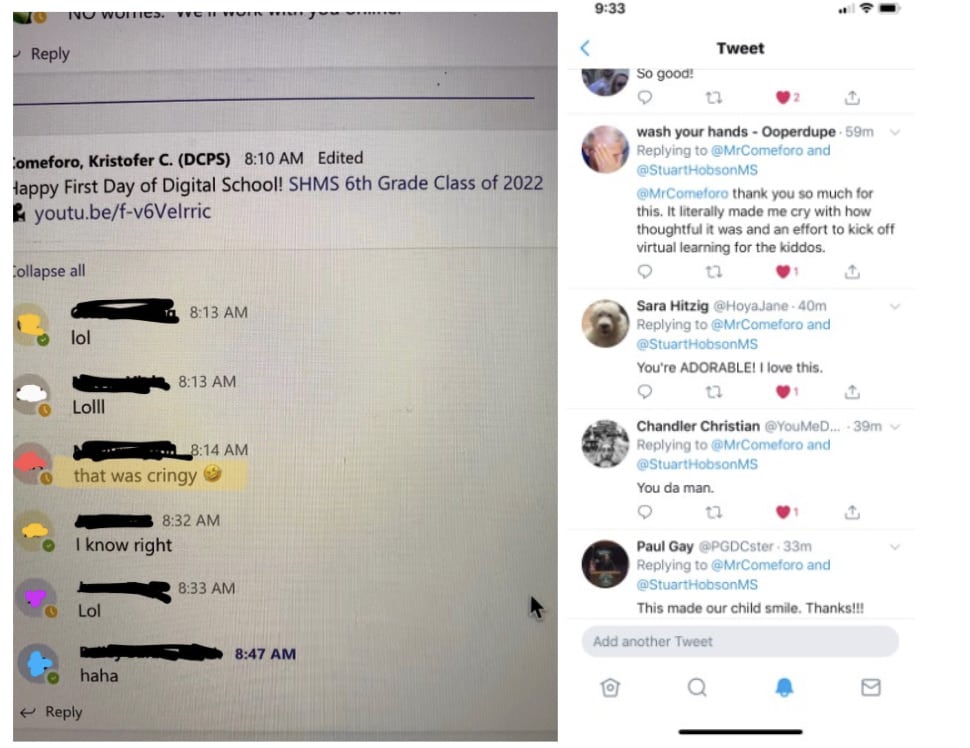
My friends and I created a feeling of connection amongst ourselves during the process, and the product provided connection to those DC families at a time when it’s needed most. We are all embarking on a new chapter of our lives as individuals and a community, one that is full of unknowns and challenges. We need these reminders to have hope and remember we’re in this together. We all want to keep working and living normally as soon as we can, but at least for now, we need to accept this new normal to learn and grow with it. Improvise, adapt, overcome.
The creative process was far from ideal from a professional viewpoint, but the resulting product was simple, it worked, and most importantly, it brought joy, a set of goals that can ring true more broadly in our imperfect world. And in an imperfect world, we need to keep seeking solutions that are simple, that work and that bring joy. It’s more important now than ever to keep connected (safely and virtually), and remember, we will get through this together.
- Ryan Savini, Creative Director
Producing in a Pandemic
There are so many aspects of being a producer that I enjoy, but when someone asks, I always say that it’s the combination of learning about companies, brands, products, and initiatives, while meeting and working with new people on each project. Unfortunately, during a global pandemic, that person-to-person camaraderie on a film, photo, or commercial set that we thrive on during our 15+ hour production days, is exactly what brings us into danger. Our industry has been halted in a matter of days, leaving brands and clients scrambling for new content, and, even worse, thousands of freelancers without work indefinitely. In a time when global couch-sitting has reached its peak and stay-at-home stamina is at an all-time low, what we need, now more than ever, are stories and storytelling that speaks to this moment. So, what do we do to keep that crucial content flowing to your screens?
We pivot. And, as filmmakers, we are damn good at it.
We’ve all had to pivot in our daily operations - when talent is late, a light bulb breaks during the best take, there’s not enough rigging equipment, catering is delayed, the EP is sick, the walkies are down, the budget is shrinking, the list goes on and on. There has never been a production day where each role didn’t face their own challenges, and that’s why we are all more prepared for these trying times than we think. Here is what we’re doing at Spot to produce in a pandemic:
-
- Develop “quarantine crews” of a few of your most trusted DPs and audio operators. If a client needs something filmed and doesn’t have the skills or equipment, you can send small 2-person crews who are pre-cleared. Once government mandated movement bans are lifted of course.
- Work with your global network. For 20 years, Spot has filmed all over the world and the US domestically, developing a trusted list of freelancers who we can hire in lieu of traveling a team.
- Use footage already owned, or buy stock. Car companies and other big brands are already doing this - use footage already shot for a previous campaign, and re-edit it with a fresh VO (recorded safely from home) to keep customers engaged, and to stay relevant to the current climate. Let your audience know that your company is informed.
- Connect to brand influencers. Influencers can be a helpful tool while larger production is halted. They have the skills and equipment to produce content from their homes, and can reach a new audience for your brand.
- Use graphics and animation. There are endless ways to produce engaging content without having any live action footage - come on, we’ve all cried over Toy Story. Use this time to try something new for your brand and engage with a new medium.
- Create virtual live events or a pre-produced program for your employees. Had to cancel that SKO but still need to get your employees pertinent information and get them excited for the year ahead? Don’t scrap the show entirely - we can reformat it for a virtual experience.
- Stay positive. Most importantly, stay positive, and think creatively on how to share that positivity with your employees, customers, and clients through media. We could all use a little light each day.
As we all adjust to the new “normal” (what does that word really mean these days?!), remember that we are all in this together - as creatives, as brands, as people. Storytelling is the root of our existence as humans, and we can’t let the fact that we can’t physically be together stifle the creation of new, interesting, dynamic, and versatile content. At Spot, we are problem solvers, we take a challenge and make it into something great. We look forward to returning to hectic set days of blood, sweat, and tears, but for now - let’s create together, while apart.
- Brittany Santagata, Head of Production


